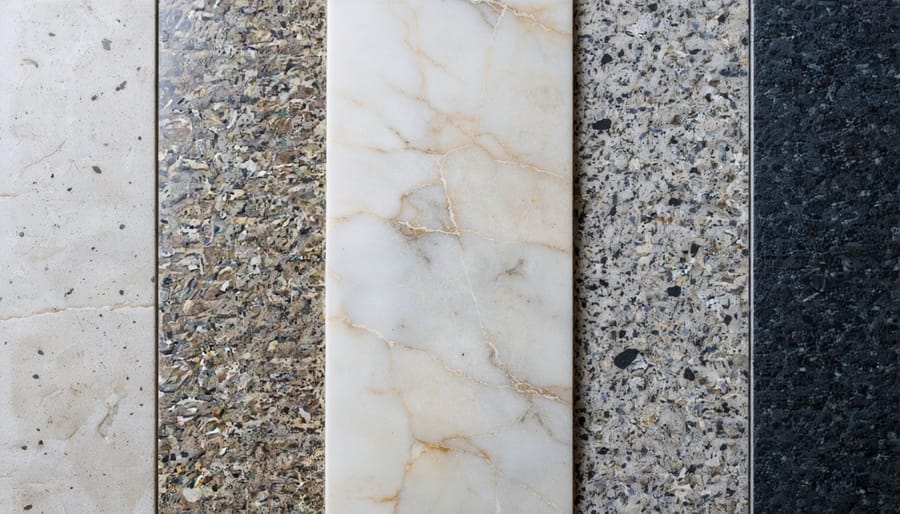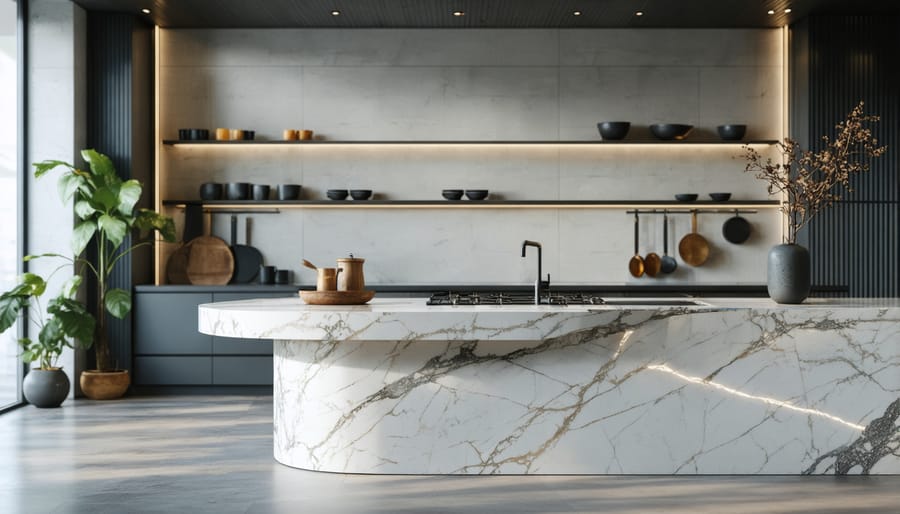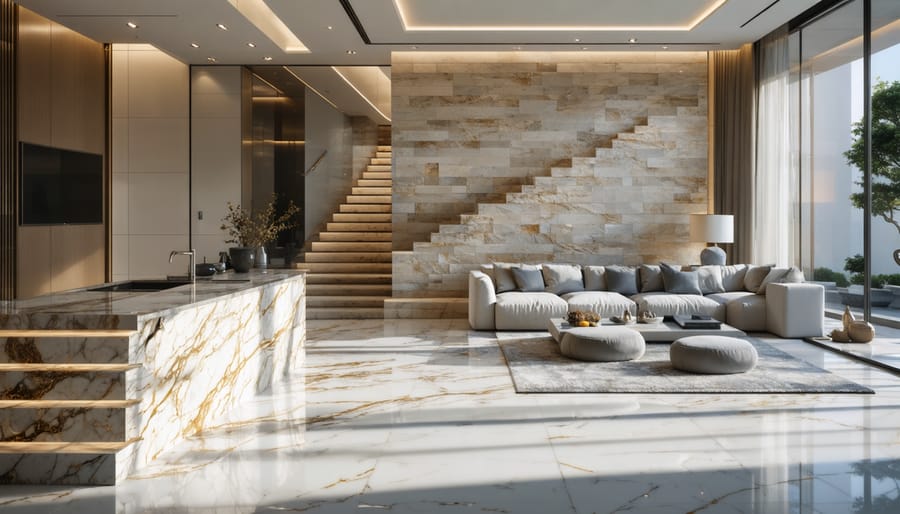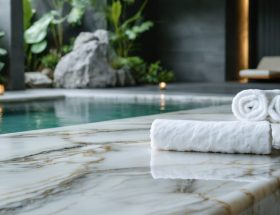Transform your living space into a sanctuary of comfort and productivity by integrating ergonomic design principles with natural elements. Strategic placement of natural stone surfaces at optimal heights reduces physical strain, while thoughtfully positioned furniture and architectural elements create intuitive movement patterns that minimize stress on the body. The inherent thermal properties of materials like marble and granite not only regulate temperature but also have a profound impact on well-being through their connection to nature.
Modern ergonomic interior design transcends traditional office-focused solutions, embracing a holistic approach that harmonizes form, function, and human biomechanics. By incorporating adjustable elements, proper lighting, and materials that promote both physical comfort and psychological ease, spaces become more than just aesthetically pleasing—they actively support health and productivity. This science-backed approach to interior design considers everything from the angle of stone countertops to the placement of natural focal points, ensuring every element serves both body and mind.
Whether designing a home office, kitchen, or living area, ergonomic principles combined with natural stone elements create environments that enhance performance while reducing physical strain and mental fatigue.
The Science Behind Stone’s Ergonomic Benefits
Temperature Regulation Properties
Natural stone’s remarkable thermal mass properties make it an excellent choice for maintaining comfortable indoor temperatures throughout the year. This inherent characteristic, one of stone’s key indoor environmental benefits, helps reduce energy consumption while creating a more stable living environment.
During summer months, stone absorbs excess heat from the air, helping to keep interior spaces naturally cooler. Conversely, in winter, it retains warmth and gradually releases it back into the room, contributing to more consistent ambient temperatures. This natural temperature regulation can lead to reduced reliance on artificial heating and cooling systems.
Different stone types exhibit varying degrees of thermal conductivity. For example, granite and marble are particularly effective at temperature regulation, while limestone and travertine offer moderate thermal mass benefits. When strategically incorporated into flooring, walls, or countertops, these materials can help create microclimates within specific areas of your home, enhancing overall comfort and energy efficiency.

Sound Absorption Benefits
Natural stone plays a crucial role in creating acoustic comfort benefits within interior spaces. Dense materials like granite, marble, and limestone effectively absorb and diffuse sound waves, reducing echo and reverberation that can cause stress and fatigue. This natural sound-dampening quality is particularly valuable in open-concept spaces, home offices, and areas where noise control is essential for productivity and wellbeing.
The varied textures and surfaces of natural stone help break up sound waves, preventing them from bouncing directly back into the space. Rough-finished stones, such as split-face limestone or textured granite, are especially effective at sound absorption. When strategically incorporated into walls, flooring, or decorative elements, stone can significantly reduce noise pollution from both external sources and internal activities.
For optimal acoustic performance, designers often combine stone elements with other sound-absorbing materials. This layered approach creates a balanced acoustic environment that supports both concentration and relaxation while maintaining the aesthetic appeal of natural materials.
Natural Stone Features That Enhance Physical Comfort
Slip-Resistant Surfaces
When it comes to ergonomic interior design, slip-resistant surfaces are crucial for safety, particularly in areas prone to moisture. Natural stone offers various finish options that can enhance traction while maintaining aesthetic appeal. The most common slip-resistant finishes include honed, brushed, and flamed surfaces, each providing different levels of grip.
Honed stone features a smooth, matte surface that offers better traction than polished finishes while retaining an elegant appearance. This finish is ideal for high-traffic areas like entryways and kitchen floors. Brushed stone surfaces have a slightly textured feel, created by wire brushing the stone’s surface. This technique is particularly effective for marble and limestone, providing excellent slip resistance without compromising the stone’s natural beauty.
Flamed finishes, created by applying intense heat to the stone’s surface, result in a highly textured, naturally slip-resistant surface. This finish is particularly popular for outdoor areas and commercial spaces where safety is paramount. For bathroom floors and shower areas, thermal finishing creates micro-grooves in the stone’s surface, significantly improving traction in wet conditions.
When selecting slip-resistant stone surfaces, consider the coefficient of friction (COF) rating. A COF rating of 0.42 or higher is recommended for interior flooring, while outdoor applications should have a minimum rating of 0.60. Regular maintenance and proper sealing help preserve these slip-resistant properties while ensuring longevity.

Natural Textures and Joint Health
Natural stone textures play a crucial role in promoting joint health and reducing physical fatigue in interior spaces. The varied surfaces of materials like limestone, granite, and slate create subtle variations underfoot that engage different muscle groups and promote better balance. This natural variability helps prevent the repetitive stress that comes from walking on completely uniform surfaces.
Research has shown that walking on slightly textured surfaces can improve proprioception – our body’s ability to sense its position in space. When incorporating stone flooring, the natural irregularities encourage micro-adjustments in posture and weight distribution, which can help reduce joint strain over time.
The inherent temperature regulation properties of stone also contribute to comfort and joint health. Unlike synthetic materials that can become uncomfortably cold or hot, natural stone maintains a more consistent temperature. This thermal stability helps reduce muscle tension and promotes better circulation, particularly important for those who stand for extended periods.
Interior designers often recommend combining different stone textures within a space to create ergonomic zones. For example, a slightly rougher texture in transition areas encourages mindful movement, while smoother finishes in rest areas provide comfort. When selecting stone materials, opt for honed or leather-finished surfaces that offer grip without being overly aggressive.
To maximize these benefits, consider installing stone flooring with proper underlayment and ensuring regular maintenance to preserve the natural texture characteristics that support joint health.
Practical Applications in Different Rooms
Kitchen Ergonomics
In the heart of every home, the kitchen demands special attention to ergonomic design, and natural stone surfaces play a crucial role in creating a comfortable cooking environment. Granite and quartz countertops, with their heat-resistant properties and durability, provide ideal work surfaces at the standard 36-inch height, though custom heights can be specified during installation to accommodate different user heights.
Stone flooring in kitchens offers both practical and ergonomic benefits. Materials like limestone and slate provide natural slip resistance while maintaining enough texture to promote proper posture during long cooking sessions. The thermal mass of stone helps regulate temperature, keeping feet comfortable during extended periods of standing. Consider installing anti-fatigue mats in high-traffic areas while maintaining the stone’s aesthetic appeal.
For maximum comfort, incorporate varying counter heights: 32 inches for prep work requiring downward force, 36 inches for standard tasks, and 42 inches for visual tasks requiring elevated surfaces. When selecting stone countertops, opt for honed or leathered finishes that reduce glare and eye strain under task lighting. Edge profiles should be rounded or beveled to prevent contact stress during food preparation.
Position frequently used appliances and storage within the “comfort zone” – between shoulder and hip height – and integrate pull-out stone shelving for easy access to heavy items. This thoughtful combination of natural stone elements creates an ergonomic kitchen that’s both functional and beautiful.

Bathroom Safety and Comfort
Natural stone applications in bathrooms go beyond mere aesthetics, playing a crucial role in creating safer and more ergonomic spaces. Non-slip stone flooring options, such as textured granite or honed limestone, provide essential traction in wet areas while maintaining visual appeal. When selecting bathroom stone, opt for materials with a minimum coefficient of friction (COF) of 0.42 for optimal slip resistance.
Strategic placement of stone elements can enhance both safety and comfort. Consider installing stone-clad shower benches at a height of 17-19 inches for comfortable seating during bathing. Grab bars mounted on stone-reinforced walls provide sturdy support, while stone threshold ramps eliminate tripping hazards between different flooring surfaces.
Temperature regulation is another ergonomic advantage of natural stone. Materials like marble maintain moderate temperatures and resist extreme heat or cold, making them comfortable underfoot. When combined with underfloor heating systems, stone flooring creates a cozy, spa-like environment while preventing condensation-related slip hazards.
For enhanced accessibility, consider wide stone countertops at varying heights to accommodate different user needs. Edge treatments should be rounded or beveled to prevent injury, while stone shower curbs should be kept low or eliminated in favor of curbless designs. Proper sealing of stone surfaces ensures long-term durability while maintaining slip-resistant properties and easy cleaning characteristics.
Living Areas and Workspaces
Natural stone elements can significantly enhance the ergonomic qualities of living and working spaces when thoughtfully incorporated. In living rooms, strategically placed stone accent walls can create visual anchors that encourage proper posture while seated. Granite or marble coffee tables with rounded edges provide both safety and functionality, while their varying heights can promote natural arm positions during daily activities.
For home offices and workspaces, stone countertops at proper heights reduce strain during extended work periods. The cool, smooth surface of polished stone can serve as a natural wrist rest, preventing repetitive stress injuries during computer work. Stone flooring, when properly installed with ergonomic mats in standing areas, provides a stable foundation that supports proper posture and reduces fatigue.
Kitchen designs benefit from stone countertops installed at customized heights for different tasks. Including stone prep areas at various levels accommodates different cooking activities and user heights, reducing back strain. Similarly, bathroom vanities crafted from natural stone can be mounted at optimal heights to prevent unnecessary bending.
Consider incorporating stone seating elements in outdoor living spaces, such as curved benches or steps that follow the body’s natural contours. These features can be designed with proper angles and depths to support comfortable sitting positions while providing thermal comfort through stone’s natural temperature-regulating properties.
Maintenance for Long-Term Ergonomic Benefits
Regular maintenance is crucial for preserving the ergonomic benefits of natural stone installations in your interior spaces. To ensure your stone surfaces continue providing optimal comfort and functionality, establish a consistent cleaning and maintenance routine that addresses both daily care and long-term preservation.
Start with daily cleaning using pH-neutral cleaners specifically formulated for natural stone. Avoid acidic or abrasive cleaning products that can damage the stone’s surface, potentially creating uncomfortable textures or compromising its ergonomic properties. Immediately clean spills to prevent staining and surface deterioration that could affect the stone’s tactile qualities.
For flooring applications, inspect and repair grout lines regularly to maintain even surfaces that prevent tripping hazards. Consider resealing your stone surfaces every 12-18 months, depending on usage and exposure. This protective layer helps preserve the stone’s natural texture and prevents wear patterns that could impact its ergonomic benefits.
Pay special attention to high-traffic areas where stone surfaces experience the most wear. Regular polishing of these areas helps maintain consistent texture and prevents the development of uncomfortable pressure points or uneven surfaces. In wet areas like bathrooms, ensure anti-slip treatments remain effective by testing surface traction periodically and reapplying treatments as needed.
Monitor temperature regulation properties by checking for any signs of damage to stone surfaces used for thermal comfort. Address any cracks or chips promptly, as these can affect the stone’s ability to maintain consistent temperatures and could create uncomfortable touch points.
For workspace surfaces, regularly assess the ergonomic height and positioning of stone countertops or desks. Verify that supporting structures remain stable and level, adjusting as necessary to maintain optimal working heights and prevent strain.
Document all maintenance activities and schedule professional inspections annually to identify potential issues before they compromise the stone’s ergonomic functionality. This proactive approach ensures your stone installations continue providing the intended comfort and usability benefits for years to come.
Natural stone stands as a remarkable material that seamlessly combines ergonomic functionality with timeless aesthetic appeal. Throughout this exploration, we’ve seen how stone’s inherent properties contribute to creating spaces that are both comfortable and conducive to wellbeing. The material’s thermal mass helps regulate temperature naturally, while its varied textures and finishes provide essential tactile feedback that enhances spatial awareness and movement.
Key takeaways from our discussion highlight that successful ergonomic design with natural stone requires careful consideration of several factors. The selection of appropriate stone types for specific applications, proper installation techniques, and thoughtful integration with other design elements all play crucial roles in maximizing ergonomic benefits. Whether used in flooring, countertops, or wall applications, natural stone can significantly improve the functionality and comfort of interior spaces.
The versatility of natural stone allows it to adapt to various ergonomic requirements across different rooms and functions. From non-slip finishes in bathrooms to heat-resistant surfaces in kitchens, stone’s adaptability makes it an invaluable material for creating user-centered environments. Additionally, its durability ensures that these ergonomic benefits remain consistent over time, making it a sustainable choice for long-term wellness-focused design.
Remember that successful ergonomic implementation with natural stone isn’t just about material selection – it’s about creating harmonious spaces that support human comfort, movement, and activities while maintaining visual appeal and functionality.










